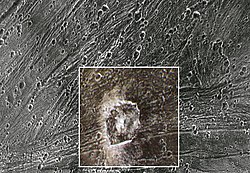
Bruce is a small lunar impact crater located in the Sinus Medii. It lies to the west-northwest of the irregular crater Rhaeticus, and is about 33 km to the west of the even smaller Blagg. It is named for Catherine Wolfe Bruce, an American philanthropist and patroness of astronomy.
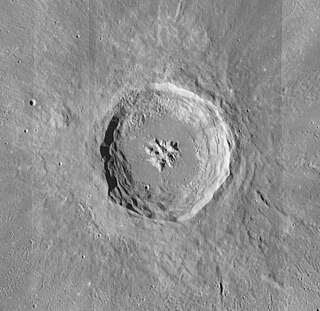
Aristillus is a prominent lunar impact crater that lies in the eastern Mare Imbrium. It was named after Greek astronomer Aristyllus. Directly to the south is the smaller crater Autolycus, while to the southwest is the large Archimedes. To the northeast are the craters Theaetetus and Cassini.
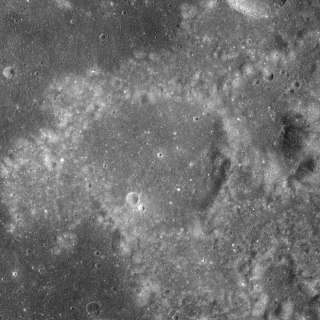
File: Franz is a small lunar impact crater identified during the Apollo mission in August 1971 and located along the eastern edge of the Sinus Amoris, a bay that forms a northern extension to the Mare Tranquillitatis. Its diameter is 25 km. It was named after German astronomer Julius Heinrich Franz. It lies to the southwest of the prominent crater Macrobius. To the north is the smaller Carmichael, and to the northwest is the diminutive Theophrastus.
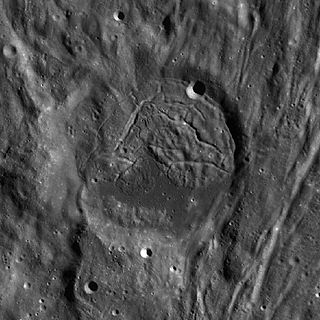
Fényi is a small lunar crater on the far side of the Moon. It lies near the southern edge of the huge, braided skirt of ejecta that surrounds the Orientale impact Basin to the north. Less than two crater diameters to the southwest is the much larger crater Mendel.

Pauli is a lunar impact crater that is located on the Moon's far side. It lies about halfway between the lunar equator and southern pole, across the southern rim of the larger walled plain Roche.

Cleopatra, initially called Cleopatra Patera, is an impact crater on Venus, in Maxwell Montes.

Arcadia Planitia is a smooth plain with fresh lava flows and Amazonian volcanic flows on Mars. It was named by Giovanni Schiaparelli in 1882 after the Arcadia region of ancient Greece. It dates from the Amazonian period's Arcadia formation's lava flows and small cinder cones. It includes a more recently developed large region of aeolian materials derived from periglacial processes. It is located northwest of the Tharsis region in the northern lowlands, spanning roughly the region 40-60° North and 150-180° West, straddling partly in the Cebrenia quadrangle (MC-07), and partly in the Diacria one (MC-02), and centered at 47.2°N 184.3°E. Arcadia marks a transition from the thinly cratered terrain to its north and the very old cratered terrain to the south. On its east it runs into the Alba Mons volcanoes. Its elevation relative to the geodetic datum varies between 0 and -3 km.
The Borealis quadrangle is a quadrangle on Mercury surrounding the north pole down to 65° latitude.

The Tolstoj quadrangle in the equatorial region of Mercury runs from 144 to 216° longitude and -25 to 25° latitude. It was provisionally called "Tir", but renamed after Leo Tolstoy by the International Astronomical Union in 1976. Also called Phaethontias.

The Michelangelo quadrangle is in the southern hemisphere of the planet Mercury, where the imaged part is heavily cratered terrain that has been strongly influenced by the presence of multiring basins. At least four such basins, now nearly obliterated, have largely controlled the distribution of plains materials and structural trends in the map area. Many craters, interpreted to be of impact origin, display a spectrum of modification styles and degradation states. The interaction between basins, craters, and plains in this quadrangle provides important clues to geologic processes that have formed the morphology of the mercurian surface.

Eminescu is a peak ring crater on Mercury 125 kilometers (78 mi) in diameter. Since there are very few later craters superposed on it, Eminescu appears to be a young crater formed around one billion years ago. It has a transitional morphology between larger more complex impact basins like Raditladi and smaller simpler central peak craters.

The Arabia quadrangle is one of a series of 30 quadrangle maps of Mars used by the United States Geological Survey (USGS) Astrogeology Research Program. The Arabia quadrangle is also referred to as MC-12.

The Amazonis quadrangle is one of a series of 30 quadrangle maps of Mars used by the United States Geological Survey (USGS) Astrogeology Research Program. The Amazonis quadrangle is also referred to as MC-8.
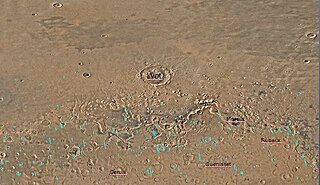
Moreux is a crater in the Ismenius Lacus quadrangle on Mars with a diameter of 138 kilometers. It is located at 42.1° north latitude and 315.6° west longitude and was named by IAU's Working Group for Planetary System Nomenclature after Theophile Moreux, a French astronomer and meteorologist (1867–1954).

Cerulli Crater is a crater in the Ismenius Lacus quadrangle on Mars with a diameter of 130 km. It is located at 32.5° north latitude and 337.9° west longitude. It lies in the northern hemisphere south of the very large crater Lyot . It is named after Vicenzo Cerulli, an Italian astronomer (1859–1927).
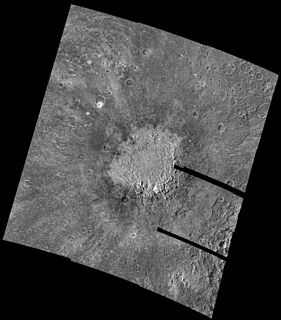
Lofn is a large relatively young impact crater on Jupiter's Galilean satellite Callisto. It was identified in 1997 and named after the goddess of marriage in Norse mythology. Located near the south pole of this moon, Lofn is classified as a flat floored or anomalous dome impact crater. It is superimposed on Adlinda multilayer structure obscuring about 30% of it. Another multi-ring structure—Heimdall is found to the south-west of Lofn.

Persbo Crater is an impact crater in the Elysium quadrangle of Mars located at 8.54° N and 203.24° W. It measures 19.5 kilometer in diameter and was named after Persbo, Sweden. Impact craters generally have a rim with ejecta around them, in contrast volcanic craters usually do not have a rim or ejecta deposits. As craters get larger they usually have a central peak. The peak is caused by a rebound of the crater floor following the impact.

Moody is an impact crater on Mercury.

Derain is a crater on Mercury named after André Derain, a French artist, painter, sculptor and co-founder of Fauvism with Henri Matisse. It has uncommonly dark material within and surrounding the crater. The material is darker than the neighboring terrain such that this crater is easily identified even in a distant global image of Mercury. The dark halo may be material with a mineralogical composition different from the majority of Mercury’s visible surface. Craters with similar dark material on or near their rims were seen on the floor of the Caloris basin during MESSENGER’s first flyby.
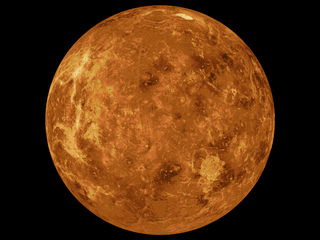
The mapping of Venus refers to the process and results of human description of the geological features of the planet Venus. It involves surface radar images of Venus, construction of geological maps, and the identification of stratigraphic units, volumes of rock with a similar age.
